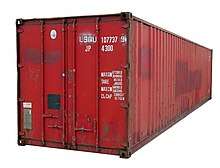Containerization
Containerization is a system of intermodal freight transport using intermodal containers (also called shipping containers and ISO containers).[1] The containers have standardized dimensions. They can be loaded and unloaded, stacked, transported efficiently over long distances, and transferred from one mode of transport to another—container ships, rail transport flatcars, and semi-trailer trucks—without being opened. The handling system is completely mechanized so that all handling is done with cranes [2] and special forklift trucks. All containers are numbered and tracked using computerized systems.
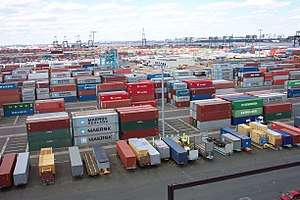
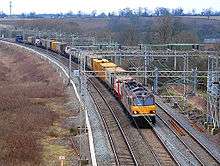
.jpg)
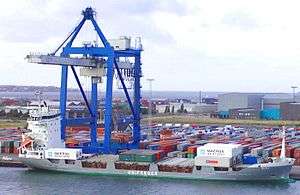
Containerization originated several centuries ago but was not well developed or widely applied until after World War II, when it dramatically reduced the costs of transport, supported the post-war boom in international trade, and was a major element in globalization. Containerization did away with the manual sorting of most shipments and the need for warehousing. It displaced many thousands of dock workers who formerly handled break bulk cargo. Containerization also reduced congestion in ports, significantly shortened shipping time and reduced losses from damage and theft.[3]
Containers can be made from a wide range of materials such as steel, fibre-reinforced polymer, aluminium or a combination of all.
Containers can be made of weathering steel to minimize maintenance needs.
Origin
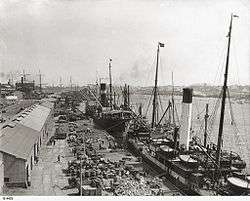
.jpg)
Before containerization, goods were usually handled manually as break bulk cargo. Typically, goods would be loaded onto a vehicle from the factory and taken to a port warehouse where they would be offloaded and stored awaiting the next vessel. When the vessel arrived, they would be moved to the side of the ship along with other cargo to be lowered or carried into the hold and packed by dock workers. The ship might call at several other ports before off-loading a given consignment of cargo. Each port visit would delay the delivery of other cargo. Delivered cargo might then have been offloaded into another warehouse before being picked up and delivered to its destination. Multiple handling and delays made transport costly, time consuming and unreliable.[3]
Containerization has its origins in early coal mining regions in England beginning in the late 18th century. In 1766 James Brindley designed the box boat 'Starvationer' with 10 wooden containers, to transport coal from Worsley Delph (quarry) to Manchester by Bridgewater Canal. In 1795, Benjamin Outram opened the Little Eaton Gangway, upon which coal was carried in wagons built at his Butterley Ironwork. The horse-drawn wheeled wagons on the gangway took the form of containers, which, loaded with coal, could be transshipped from canal barges on the Derby Canal, which Outram had also promoted.[4]
By the 1830s, railroads on several continents were carrying containers that could be transferred to other modes of transport. The Liverpool and Manchester Railway in the United Kingdom was one of these. "Simple rectangular timber boxes, four to a wagon, they were used to convey coal from the Lancashire collieries to Liverpool, where they were transferred to horse-drawn carts by crane."[5] Originally used for moving coal on and off barges, "loose boxes" were used to containerize coal from the late 1780s, at places like the Bridgewater Canal. By the 1840s, iron boxes were in use as well as wooden ones. The early 1900s saw the adoption of closed container boxes designed for movement between road and rail.
Twentieth century
On 17 May 1917, Benjamin Franklin Fitch inaugurated exploitation of an experimental installation for transfer of the containers called demountable bodies based on his own design in Cincinnati, Ohio in US. Later in 1919, his system was extended to over 200 containers serving 21 railway stations with 14 freight trucks.
Prior to the Second World War, many European countries independently developed container systems.
In 1919, Stanisław Rodowicz, an engineer, developed the first draft of the container system in Poland. In 1920, he built a prototype of the biaxial wagon. The Polish-Bolshevik War stopped development of the container system in Poland.[6]
The US Post Office contracted with the New York Central Railroad to move mail via containers in May 1921. In 1930, the Chicago & Northwestern Railroad began shipping containers between Chicago and Milwaukee. However, their efforts ended in the spring of 1931 when the Interstate Commerce Commission wouldn't allow the use of a flat rate for the containers.[7]
In 1926, a regular connection of the luxury passenger train from London to Paris, Golden Arrow/Fleche d'Or, by Southern Railway and French Northern Railway, began. For transport of passengers' baggage four containers were used. These containers were loaded in London or Paris and carried to ports, Dover or Calais, on flat cars in the UK and "CIWL Pullman Golden Arrow Fourgon of CIWL" in France. At the Second World Motor Transport Congress in Rome, September 1928, Italian senator Silvio Crespi proposed the use of containers for road and railway transport systems, using collaboration rather than competition. This would be done under the auspices of an international organ similar to the Sleeping Car Company, which provided international carriage of passengers in sleeping wagons. In 1928 Pennsylvania Railroad (PRR) started regular container service in the northeast United States. After the Wall Street Crash of 1929 in New York and the subsequent Great Depression, many countries were without any means of transport for cargo. The railroads were sought as a possibility to transport cargo, and there was an opportunity to bring containers into broader use. Under auspices of the International Chamber of Commerce in Paris in Venice on September 30, 1931, on one of the platforms of the Maritime Station (Mole di Ponente), practical tests were done to assess the best construction for European containers as part of an international competition.[8]
In the same year, 1931, in USA Benjamin Franklin Fitch designed the two largest and heaviest containers in existence anywhere at the time. One measured 17'6" by 8'0" by 8'0" with a capacity of 30,000 pounds in 890 cubic feet, and a second measured 20'0" by 8'0" by 8'0", with a capacity of 50,000 pounds in 1,000 cubic feet.
In November 1932 in Enola, PA the first container terminal in the world was opened by The Pennsylvania Railroad Company.[8] The Fitch hooking system was used for reloading of the containers.
The development of containerization was created in Europe and the US as a way to revitalize rail companies after the Wall Street Crash of 1929, which had caused economic collapse and reduction in use of all modes of transport [8]
In 1933 in Europe under the auspices of the International Chamber of Commerce the International Container Bureau (French: Bureau International des Conteneurs, B.I.C.) was established. In June 1933, the B.I.C. decided on obligatory parameters for containers used in international traffic. Containers handled by means of lifting gear, such as cranes, overhead conveyors, etc. for traveling elevators (group I containers), constructed after July 1, 1933. Obligatory Regulations:
- Clause 1.—Containers are, as regards form, either of the closed or the open type, and, as regards capacity, either of the heavy or the light type.
- Clause 2.—The loading capacity of containers must be such that their total weight (load, plus tare) is: 5 metric tons for containers of the heavy type; 2.5 metric tons for containers of the light type; a tolerance of 5 percent excess on the total weight is allowable under the same conditions as for wagon loads.[8]
| Category | length [m] | width [m] | high [m] | Total mass [tons] |
|---|---|---|---|---|
| Heavy types | ||||
| Close type 62 | 3.25 | 2.15 | 2.20 | 5 |
| Close type 42 | 2.15 | 2.15 | 2.20 | |
| Open type 61 | 3.25 | 2.15 | 1.10 | |
| Open type 41 | 2.15 | 2.15 | 1.10 | |
| Light Type | ||||
| Close type 22 | 2.15 | 1.05 | 2.20 | 2.5 |
| Close type 201 | 2.15 | 1.05 | 1.10 | |
| Open type 21 | 2.15 | 1.05 | 1.10 | |
In April 1935 BIC established second standard for European containers:[8]
| Category | Length [m] | Width [m] | High [m] | Total mass [tons] |
|---|---|---|---|---|
| Heavy types | ||||
| Close 62 | 3.25 | 2.15 | 2.550 | 5 |
| Close 42 | 2.15 | 2.15 | 2.550 | |
| Open 61 | 3.25 | 2.15 | 1.125 | |
| Open 41 | 2.15 | 2.15 | 1.125 | |
| Light type | ||||
| Close 32 | 1.50 | 2.15 | 2.550 | 2.5 |
| Close 22 | 1.05 | 2.15 | 2.550 | |
From 1926 to 1947 in the United States, the Chicago North Shore and Milwaukee Railway carried motor carrier vehicles and shippers' vehicles loaded on flatcars between Milwaukee, Wisconsin, and Chicago, Illinois. Beginning in 1929, Seatrain Lines carried railroad boxcars on its sea vessels to transport goods between New York and Cuba.[9]
In the mid-1930s, the Chicago Great Western Railway and then the New Haven Railroad began "piggyback" service (transporting highway freight trailers on flatcars) limited to their own railroads. The Chicago Great Western Railway filed a US federal patent in 1938 on their method of securing each trailer to a flatcar using chains and turnbuckles. Other components included wheel chocks and ramps for loading and unloading the trailers from the flatcars.[10] By 1953, the Chicago, Burlington and Quincy, the Chicago and Eastern Illinois, and the Southern Pacific railroads had joined the innovation. Most of the railcars used were surplus flatcars equipped with new decks. By 1955, an additional 25 railroads had begun some form of piggyback trailer service.
World War II
During World War II, the Australian Army used containers to help more easily deal with various breaks of gauge in the railroads. These non-stackable containers were about the size of the later 20-foot ISO container and perhaps made mainly of wood.[11]
During the same time, the United States Army started to combine items of uniform size, lashing them onto a pallet, unitizing cargo to speed the loading and unloading of transport ships. In 1947 the Transportation Corps developed the Transporter, a rigid, corrugated steel container with a 9,000 lb (4.1 t) carrying capacity, for shipping household goods of officers in the field. It was 8' 6" long, 6' 3" wide, and 6' 10" high (2.59 x 1.91 x 2.08 m), with double doors on one end, mounted on skids, and had lifting rings on the top four corners.[12][13] During the Korean War the Transporter was evaluated for handling sensitive military equipment and, proving effective, was approved for broader use. Theft of material and damage to wooden crates convinced the army that steel containers were needed.
.jpg)
Mid-twentieth century
In April 1951, at Zürich Tiefenbrunnen railway station, the Swiss Museum of Transport and Bureau International des Containers (BIC) held demonstrations of container systems, with the aim of selecting the best solution for Western Europe. Present were representatives from France, Belgium, the Netherlands, Germany, Switzerland, Sweden, Great Britain, Italy and the United States. The system chosen for Western Europe was based on the Netherlands' system for consumer goods and waste transportation called Laadkisten (literally, "loading bins"), in use since 1934. This system used roller containers that were moved by rail, truck and ship, in various configurations up to a capacity of 5,500 kg (12,100 lb), and up to 3.1 by 2.3 by 2 metres (10 ft 2 in × 7 ft 6 1⁄2 in × 6 ft 6 3⁄4 in) size.[14][15] This became the first post World War II European railway standard UIC 590, known as "pa-Behälter." It was implemented in the Netherlands, Belgium, Luxembourg, West Germany, Switzerland, Sweden and Denmark.[16] With the popularization of the larger ISO containers, support for pa containers was phased out by the railways. In the 1970s they began to be widely used for transporting waste.[16]
In 1952 the US Army developed the Transporter into the CONtainer EXpress or CONEX box system. The size and capacity of the Conex were about the same as the Transporter,[nb 1] but the system was made modular, by the addition of a smaller, half-size unit of 6 ft 3 in (1.91 m) long, 4 ft 3 in (1.30 m) wide and 6 ft 10 1⁄2 in (2.10 m) high.[19][20][nb 2] CONEXes could be stacked three high, and protected their contents from the elements.[17]
The first major shipment of CONEXes, containing engineering supplies and spare parts, was made by rail from the Columbus General Depot in Georgia to the Port of San Francisco, then by ship to Yokohama, Japan, and then to Korea, in late 1952; shipment times were almost halved. By the time of the Vietnam War the majority of supplies and materials were shipped by CONEX. By 1965 the US military used some 100,000 Conex boxes, and more than 200,000 in 1967.[20][24] making this the first worldwide application of intermodal containers.[17] After the US Department of Defense standardized an 8-by-8-foot (2.44 by 2.44 m) cross section container in multiples of 10-foot (3.05 m) lengths for military use, it was rapidly adopted for shipping purposes.
In 1955, former trucking company owner Malcom McLean worked with engineer Keith Tantlinger to develop the modern intermodal container. The challenge was to design a shipping container that could efficiently be loaded onto ships and would hold securely on long sea voyages. The result was a 8 feet (2.44 m) tall by 8 ft (2.44 m) wide box in 10 ft (3.05 m)-long units constructed from 2.5 mm (0.098 in) thick corrugated steel. The design incorporated a twistlock mechanism atop each of the four corners, allowing the container to be easily secured and lifted using cranes. After helping McLean create the successful design, Tantlinger convinced him to give the patented designs to industry; this began international standardization of shipping containers.[25]
Purpose-built ships
The first vessels purpose-built to carry containers had begun operation in 1926 for the regular connection of the luxury passenger train between London and Paris, the Golden Arrow/Fleche d'Or. Four containers were used for the conveyance of passengers' baggage. These containers were loaded in London or Paris and carried to the ports of Dover or Calais.[8]
The next step was in Europe was after the Second World War. Vessels purpose-built to carry containers were used between UK and Netherlands [16] and also in Denmark in 1951.[26]:31 In the United States, ships began carrying containers in 1951, between Seattle, Washington and Alaska.[27] However, none of these services was particularly successful. First, the containers were rather small, with 52% of them having a volume of less than 3 cubic metres (106 cu ft). Almost all European containers were made of wood and used canvas lids, and they required additional loading into rail or truck bodies.[26]:31–32
The world's first purpose-built container vessel was Clifford J. Rodgers,[28] built in Montreal in 1955 and owned by the White Pass and Yukon Corporation.[29] Her first trip carried 600 containers between North Vancouver, British Columbia, and Skagway, Alaska, on November 26, 1955; in Skagway, the containers were unloaded to purpose-built railroad cars for transport north to Yukon, in the first intermodal service using trucks, ships, and railroad cars.[30] Southbound containers were loaded by shippers in Yukon and moved by rail, ship, and truck to their consignees without opening. This first intermodal system operated from November 1955 until 1982.[31]
The first truly successful container shipping company dates to April 26, 1956, when American trucking entrepreneur McLean put 58 trailer vans [32] later called containers, aboard a refitted tanker ship, the SS Ideal X, and sailed them from Newark, New Jersey to Houston, Texas.[26]:1 Independently of the events in Canada, McLean had the idea of using large containers that never opened in transit and that were transferable on an intermodal basis, among trucks, ships, and railroad cars. McLean had initially favored the construction of "trailerships"—taking trailers from large trucks and stowing them in a ship's cargo hold. This method of stowage, referred to as roll-on/roll-off, was not adopted because of the large waste in potential cargo space on board the vessel, known as broken stowage. Instead, McLean modified his original concept into loading just the containers, not the chassis, onto the ship; hence the designation "container ship" or "box" ship.[33][34] (See also pantechnicon van and trolley and lift van.)
Toward standards
.jpg)
During the first 20 years of containerization, many container sizes and corner fittings were used; there were dozens of incompatible container systems in the United States alone. Among the biggest operators, the Matson Navigation Company had a fleet of 24-foot (7.32 m) containers, while Sea-Land Service, Inc used 35-foot (10.67 m) containers. The standard sizes and fitting and reinforcement norms that now exist evolved out of a series of compromises among international shipping companies, European railroads, US railroads, and US trucking companies. Four important ISO (International Organization for Standardization) recommendations standardized containerization globally:[35]
- January 1968: ISO 668 defined the terminology, dimensions and ratings.
- July 1968: R-790 defined the identification markings.
- January 1970: R-1161 made recommendations about corner fittings.
- October 1970: R-1897 set out the minimum internal dimensions of general purpose freight containers.
Based on these standards, the first TEU container ship was the Japanese de:Hakone Maru from shipowner NYK, who started sailing in 1968 and could carry 752 TEU containers.
In the United States, containerization and other advances in shipping were impeded by the Interstate Commerce Commission (ICC), which was created in 1887 to keep railroads from using monopolist pricing and rate discrimination but fell victim to regulatory capture. By the 1960s, ICC approval was required before any shipper could carry different items in the same vehicle or change rates. The fully integrated systems in the United States today became possible only after the ICC's regulatory oversight was cut back (and abolished in 1995); trucking and rail were deregulated in the 1970s and maritime rates were deregulated in 1984.[36]
Double-stacked rail transport, where containers are stacked two high on railway cars, was introduced in the United States. The concept was developed by Sea-Land and the Southern Pacific railroad. The first standalone double-stack container car (or single-unit 40-ft COFC well car) was delivered in July 1977. The 5-unit well car, the industry standard, appeared for the first time in 1981. Initially, these double-stack railway cars were deployed in regular train service. Ever since American President Lines initiated in 1984 a dedicated double-stack container train service between Los Angeles and Chicago, transport volumes increased rapidly.
Effects
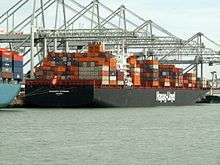
Containerization greatly reduced the expense of international trade and increased its speed, especially of consumer goods and commodities. It also dramatically changed the character of port cities worldwide. Prior to highly mechanized container transfers, crews of 20–22 longshoremen would pack individual cargoes into the hold of a ship. After containerization, large crews of longshoremen were no longer necessary at port facilities, and the profession changed drastically.
Meanwhile, the port facilities needed to support containerization changed. One effect was the decline of some ports and the rise of others. At the Port of San Francisco, the former piers used for loading and unloading were no longer required, but there was little room to build the vast holding lots needed for container transport. As a result, the Port of San Francisco virtually ceased to function as a major commercial port, but the neighboring port of Oakland emerged as the second largest on the US West Coast. A similar fate met the relation between the ports of Manhattan and New Jersey. In the United Kingdom, the Port of London and Port of Liverpool declined in importance. Meanwhile, Britain's Port of Felixstowe and Port of Rotterdam in the Netherlands emerged as major ports. In general, inland ports on waterways incapable of deep-draft ship traffic also declined from containerization in favor of seaports. With intermodal containers, the job of sorting and packing containers could be performed far from the point of embarking.
The effects of containerization rapidly spread beyond the shipping industry. Containers were quickly adopted by trucking and rail transport industries for cargo transport not involving sea transport. Manufacturing also evolved to adapt to take advantage of containers. Companies that once sent small consignments began grouping them into containers. Many cargoes are now designed to fit precisely into containers. The reliability of containers also made just in time manufacturing possible as component suppliers could deliver specific components on regular fixed schedules.
In 2004, the global container's traffic was of 354 millions of TEU, with an estimated 82-per-cent share handled by the top-100 container ports.[37]
Twenty-first century
As of 2009, approximately 90% of non-bulk cargo worldwide is moved by containers stacked on transport ships;[38] 26% of all container transshipment is carried out in China.[39] For example, in 2009 there were 105,976,701 transshipments in China (both international and coastal, excluding Hong Kong), 21,040,096 in Hong Kong (which is listed separately), and only 34,299,572 in the United States. In 2005, some 18 million containers made over 200 million trips per year. Some ships can carry over 14,500 twenty-foot equivalent units (TEU), such as the Emma Mærsk, 396 m (1,299 ft) long, launched in August 2006. It has been predicted that, at some point, container ships will be constrained in size only by the depth of the Straits of Malacca, one of the world's busiest shipping lanes, linking the Indian Ocean to the Pacific Ocean. This so-called Malaccamax size constrains a ship to dimensions of 470 m (1,542 ft) in length and 60 m (197 ft) wide.[34]
However, few initially foresaw the extent of the influence of containerization on the shipping industry. In the 1950s, Harvard University economist Benjamin Chinitz predicted that containerization would benefit New York by allowing it to ship its industrial goods more cheaply to the Southern United States than other areas, but he did not anticipate that containerization might make it cheaper to import such goods from abroad. Most economic studies of containerization merely assumed that shipping companies would begin to replace older forms of transportation with containerization, but did not predict that the process of containerization itself would have a more direct influence on the choice of producers and increase the total volume of trade.[34]
The widespread use of ISO standard containers has driven modifications in other freight-moving standards, gradually forcing removable truck bodies or swap bodies into standard sizes and shapes (though without the strength needed to be stacked), and changing completely the worldwide use of freight pallets that fit into ISO containers or into commercial vehicles.
Improved cargo security is also an important benefit of containerization. Once the cargo is loaded into a container, it isn't touched again until it reaches its destination. [40] The cargo is not visible to the casual viewer and thus is less likely to be stolen; the doors of the containers are usually sealed so that tampering is more evident. Some containers are fitted with electronic monitoring devices and can be remotely monitored for changes in air pressure, which happens when the doors are opened. This reduced the thefts that had long plagued the shipping industry. Recent developments have focused on the use of intelligent logistics optimization to further enhance security.
The use of the same basic sizes of containers across the globe has lessened the problems caused by incompatible rail gauge sizes in different countries. The majority of the rail networks in the world operate on a 1,435 mm (4 ft 8 1⁄2 in) gauge track known as standard gauge, but many countries (such as Russia, India, Finland, and Lithuania) use broader gauges, while many others in Africa and South America use narrower gauges on their networks. The use of container trains in all these countries makes transshipment between different trains of different gauges easier.
Containers have become a popular way to ship private cars and other vehicles overseas using 20- or 40-foot containers. Unlike roll-on/roll-off vehicle shipping, personal effects can be loaded into the container with the vehicle, allowing for easy international relocation.
In July, 2020, The Digital Container Shipping Association (DCSA), a non-profit group established to further digitalisation of container shipping technology standards, published standards for the digital exchange of operational vessel schedules (OVS).[41]
Container standards
ISO standard
There are five common standard lengths:
- 20 ft (6.10 m)
- 40 ft (12.19 m)
- 45 ft (13.72 m)
- 48 ft (14.63 m)
- 53 ft (16.15 m)
US domestic standard containers are generally 48 ft (14.63 m) and 53 ft (16.15 m) (rail and truck). Container capacity is often expressed in twenty-foot equivalent units (TEU, or sometimes teu). An equivalent unit is a measure of containerized cargo capacity equal to one standard 20 ft (6.10 m) (length) × 8 ft (2.44 m) (width) container. As this is an approximate measure, the height of the box is not considered. For instance, the 9 ft 6 in (2.90 m) high cube and the 4 ft 3 in (1.30 m) half height 20 ft (6.10 m) containers are also called one TEU. 48' containers have been phased out over the last ten years in favor of 53' containers.
The maximum gross mass for a 20 ft (6.10 m) dry cargo container was initially set at 24,000 kg (53,000 lb), and 30,480 kg (67,200 lb)for a 40 ft (12.19 m) container (including the 9 ft 6 in or 2.90 m high cube) . Allowing for the tare mass of the container, the maximum payload mass is therefore reduced to approximately 22,000 kg (49,000 lb) for 20 ft (6.10 m), and 27,000 kg (60,000 lb) for 40 ft (12.19 m) containers.[42]
It was increased to 30,480 kg for the 20' in 2005, then further increased to a max of 36,000 kg for all sizes by the amendment 2 (2016) of the ISO standard 668 (2013).
The original choice of 8-foot (2.44 m) height for ISO containers was made in part to suit a large proportion of railway tunnels, though some had to be modified. The current standard is eight feet six inches (2.59 m) high. With the arrival of even taller hi-cube containers at nine feet six inches (2.90 m) and double stacking rail cars, further enlargement of the rail loading gauge is proving necessary.[43]
Air freight containers
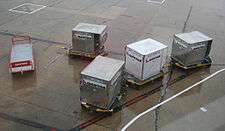
While major airlines use containers that are custom designed for their aircraft and associated ground handling equipment the IATA has created a set of standard aluminium container sizes of up to 11.52 m3 (407 cu ft) in volume.
Other container system standards
Some other container systems (in date order) are:
- (1922) NYC container[44]
- (1924) von-Haus-zu-Haus (house to house; Germany)[45]
- Japanese railway containers: Containers used by the Japan Freight Railway Company
- (1925) Mack[46]
- (1927) English Railway container[47][48][49]
- (1928) Victorian Railways – refrigerated container[50]
- (1929) International Competition[51]
- (1930) GWR Container[52]
- (1931) International Chamber of Commerce[53]
- (1933) International Container Bureau:[8][54]
- (1936) SAR Wolseley break of gauge[55][55]
- (1946) Queensland Railways milk container, 2,000 imperial gallons (9,100 L; 2,400 US gal), road-rail[56]
- (1978) RACE (Australia) – slightly wider than ISO containers to fit slightly wider Australian Standard Pallets
- (1994) ACTS roller containers for intermodal transport by rail and road (Central Europe)
- (1998) PODS
- (2005?) SECU (Sweden, Finland, UK) – big 95 t (93 long tons; 105 short tons) container.
- Pallet-wide containers are used in Europe and have length (45, 40 or 20 ft or 13.72, 12.19 or 6.10 m) and height like ISO-containers, but they are 2.484 m (8 ft 1.8 in) wide externally and 2.420 m (7 ft 11.3 in) internally to fit EUR-pallet better.[57] They are meant for transport inside Europe and are often accepted in ships.
Container loading
Full container load
A full container load (FCL) is an ISO standard container that is loaded and unloaded under the risk and account of one shipper and only one consignee. In practice, it means that the whole container is intended for one consignee. FCL container shipment tends to have lower freight rates than an equivalent weight of cargo in bulk. FCL is intended to designate a container loaded to its allowable maximum weight or volume, but FCL in practice on ocean freight does not always mean a full payload or capacity - many companies will prefer to keep a 'mostly' full container as a single container load to simplify logistics and increase security compared to sharing a container with other goods.
Less-than-container load
Less-than-container load (LCL) is a shipment that is not large enough to fill a standard cargo container. The abbreviation LCL formerly applied to "less than (railway) car load" for quantities of material from different shippers or for delivery to different destinations carried in a single railway car for efficiency. LCL freight was often sorted and redistributed into different railway cars at intermediate railway terminals en route to the final destination.[58]
LCL is "a quantity of cargo less than that required for the application of a carload rate. A quantity of cargo less than that which fills the visible or rated capacity of an inter-modal container." It can also be defined as "a consignment of cargo which is inefficient to fill a shipping container. It is grouped with other consignments for the same destination in a container at a container freight station".[59]
Issues
Hazards
Containers have been used to smuggle contraband. The vast majority of containers are never subjected to scrutiny due to the large number of containers in use. In recent years there have been increased concerns that containers might be used to transport terrorists or terrorist materials into a country undetected. The US government has advanced the Container Security Initiative (CSI), intended to ensure that high-risk cargo is examined or scanned, preferably at the port of departure.
Empty containers
Containers are intended to be used constantly, being loaded with new cargo for a new destination soon after having been emptied of previous cargo. This is not always possible, and in some cases, the cost of transporting an empty container to a place where it can be used is considered to be higher than the worth of the used container. Shipping lines and container leasing companies have become expert at repositioning empty containers from areas of low or no demand, such as the US West Coast, to areas of high demand, such as China. Repositioning within the port hinterland has also been the focus of recent logistics optimization work. However, damaged or retired containers may also be recycled in the form of shipping container architecture, or the steel content salvaged. In the summer of 2010, a worldwide shortage of containers developed as shipping increased after the recession, while new container production had largely ceased.[60]
Loss at sea
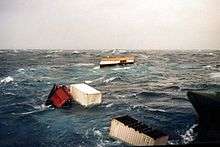
Containers occasionally fall from ships, usually during storms; according to media sources, between 2,000[61] and 10,000 containers are lost at sea each year.[62] The World Shipping Council states in a survey among freight companies that this claim is grossly excessive and calculated an average of 350 containers to be lost at sea each year, or 675 if including catastrophic events.[63] For instance, on November 30, 2006, a container washed ashore[64] on the Outer Banks of North Carolina, along with thousands of bags of its cargo of Doritos Chips. Containers lost in rough waters are smashed by cargo and waves, and often sink quickly.[61] Although not all containers sink, they seldom float very high out of the water, making them a shipping hazard that is difficult to detect. Freight from lost containers has provided oceanographers with unexpected opportunities to track global ocean currents, notably a cargo of Friendly Floatees.[65]
In 2007 the International Chamber of Shipping and the World Shipping Council began work on a code of practice for container storage, including crew training on parametric rolling, safer stacking, the marking of containers, and security for above-deck cargo in heavy swell.[66][67]
In 2011, the MV Rena ran aground off the coast of New Zealand. As the ship listed, some containers were lost, while others were held on board at a precarious angle.
Trade union challenges
Some of the biggest battles in the container revolution were waged in Washington, D.C.. Intermodal shipping got a huge boost in the early 1970s, when carriers won permission to quote combined rail-ocean rates. Later, non-vessel-operating common carriers won a long court battle with a US Supreme Court decision against contracts that attempted to require that union labor be used for stuffing and stripping containers at off-pier locations.[68]
Other uses for containers
Shipping container architecture is the use of containers as the basis for housing and other functional buildings for people, either as temporary or a permanent housing, and either as a main building or as a cabin or as a workshop. Containers can also be used as sheds or storage areas in industry and commerce.
Tempo Housing in Amsterdam stacks containers for individual housing units.
Containers are also beginning to be used to house computer data centers, although these are normally specialized containers.
There is now a high demand for containers to be converted in the domestic market to serve specific purposes.[69] As a result, a number of container-specific accessories have become available for a variety of applications, such as racking for archiving, lining, heating, lighting, powerpoints to create purpose-built secure offices, canteens and drying rooms, condensation control for furniture storage, and ramps for storage of heavier objects. Containers are also converted to provide equipment enclosures, pop-up cafes, exhibition stands, security huts and more.
Public containerised transport[70] is the concept, not yet implemented, of modifying motor vehicles to serve as personal containers in non-road passenger transport.
The ACTS roller container standards have become the basis of containerized firefighting equipment throughout Europe.
BBC tracking project
On September 5, 2008, the BBC embarked on a year-long project to study international trade and globalization by tracking a shipping container on its journey around the world.[71][72]
See also
- 2000s energy crisis
- Container terminal design process
- Henry Robinson Palmer described an early principle of containerization.
- Inter-box connector
- Intermodal container
- List of cargo types
- List of world's busiest container ports
- Little Eaton Gangway 1798
- Multimodal transport
- NYC container 1922
- Shipping portal
- Stowage plan for container ships
- Tanktainers
- Unit load
Notes
- (8’6" length, 6’3" width and 6’10½" height, and 9000 lbs capacity),[17][18]
- Some sources also mention a 12-foot version.[21][22] and a third version, the Conex III of 8 by 8 by 6.5 feet (2.44 m × 2.44 m × 1.98 m), and a capacity of 13,000 lbs was being developed. Connecting devices were intended to join three Conex-III containers together into one 20-feet long unit, a standard recommended by the American Standards Association, for use in commercial rail, highway, and water shipping.[23]
References
- Edmonds, John (2017-03-03). "The Freight Essentials: Getting Your Products Across The Ocean". Retrieved 2017-09-01.
- Lewandowski, Krzysztof (2016). "Growth in the Size of Unit Loads and Shipping Containers from Antique to WWI". Packaging Technology and Science. 29 (8–9): 451–478. doi:10.1002/pts.2231. ISSN 1099-1522.
- Levinson, Marc. "Sample Chapter for Levinson, M.: The Box: How the Shipping Container Made the World Smaller and the World Economy Bigger". The Box: How the Shipping Container Made the World Smaller and the World Economy Bigger. Princeton University Press. Archived from the original on 22 January 2013. Retrieved 17 February 2013.
- Ripley, David (1993). The Little Eaton Gangway and Derby Canal (Second ed.). Oakwood Press. ISBN 0-85361-431-8.
- Essery, R. J, Rowland. D. P. & Steel W. O. British Goods Wagons from 1887 to the Present Day. Augustus M. Kelly Publishers. New York USA. 1979 Page 92
- Lewandowski, Krzysztof (2014). "Stanisław Rodowicz, Eng. The Forgotten Pioneer of Containerization in Poland". Logistics and Transport. 23 (3): 73–78. ISSN 1734-2015.
- Grant, H. Roger (1996). The Northwestern A History of the Chicago & North Western Railway System. DeKalb, IL: Northern Illinois University Press. p. 156. ISBN 978-0-87580-214-5.
- Lewandowski, Krzysztof (2014). "Czechoslovak activity to prepare European norms for containers before the Second World War" (PDF). Acta Logistica. 1 (4): 1–7. doi:10.22306/al.v1i4.25. ISSN 1339-5629.
- Mohowski, Robert E. (Spring 2011). "Seatrain: Railroad or steamship line?". Classic Trains: 64–73.
- The Chicago Great Western Railway, David J. Fiore, Sr., Charleston, South Carolina: Arcadia Publishing, 2006, p. 51
- With Iron Rails p8.26 by David Burke 1988
- Van Ham, Hans; Rijsenbrij, Joan (2012-12-15). Development of Containerization. Amsterdam: IOS Press. p. 8. ISBN 978-1614991465. Retrieved 27 July 2015.
- "History & Development of the Container — The "Transporter", predecessor to the CONEX". www.transportation.army.mil. U.S. Army Transportation Museum. 15 May 2013. Archived from the original on 20 July 2015. Retrieved 20 July 2015.
- M.K. "Vorläufer der heutigen Container: pa, BT und B900" [Predecessors of today's containers: pa, BT and B900]. MIBA (in German) (Special 54): 12–19. Retrieved 23 July 2015.
- Nico Spilt. "Laadkistvervoer - Langs de rails" [Loading bin transport] (in Dutch). Archived from the original on 20 July 2015. Retrieved 20 July 2015.
- Lewandowski, Krzysztof (2014). "Wymagania Organizacyjne Stosowania Systemu ACTS" [Organizational Requirements Use the ACTS System] (PDF). Pojazdy Szynowe (in Polish). 2: 1–14. ISSN 0138-0370.
- Heins, Matthew (2013). "2" (PDF). The Shipping Container and the Globalization of American Infrastructure (dissertation). University of Michigan. p. 15. Retrieved 21 July 2015.
- Levinson, Marc (2006). "7" (PDF). The Box: How the Shipping Container Made the World Smaller and the World Economy Bigger. Princeton, N.J.: Princeton University Press. p. 127. ISBN 978-0-691-12324-0. Retrieved 21 July 2015.
- Logistic Support in the Vietnam Era (PDF) (Report). 7: Containerization. US DoD Joint Logistics Review Board. 15 December 1970. p. 10. Retrieved 22 July 2015.
The dimensions of the CONEX II are 75 by 82½ by 102 in. The CONEX container is a metal reusable shipping box. The most common type has a 295-cu. ft. capacity, is about 8½ by 6 by 7 ft, and can carry 9,000 lbs. The dimensions of the Half-CONEX or CONEX I container are 75 by 82¼ by 51 in.
- Development of Containerization // J. van Ham, J. Rijsenbrij: Steel containers (page 8)
- Falloff // Robert Flanagan: Fleeing G.o.D. (page 7)
- Michael J. Everhart (7 July 2014). "My Vietnam Tour - 1970". Retrieved 21 July 2015.
.. CONEX ... container that ... was about 7' high by 8' wide and about 12' long...
- "Reusable Metal Shipping Container (Conex III)". Defense Technical Information Center. 1968. Archived from the original on 2015-07-27. Retrieved 2015-07-27.
- Logistic Support in the Vietnam Era (PDF) (Report). 7: Containerization. US DoD Joint Logistics Review Board. 15 December 1970. pp. 9–11. Retrieved 22 July 2015.
- McGough, Roger (Narrator), McAulay, Graeme (Director & Producer), Crossley-Holland, Dominic (Executive Producer) (2010). The Box that Changed Britain. BBC4 (documentary). BBC.
- Marc Levinson (2006). The Box: How the Shipping Container Made the World Smaller and the World Economy Bigger. Princeton Univ. Press. ISBN 978-0-691-12324-0.
- Antonson, Joan M.; Hanable, William S. (1985). Alaska's heritage. Alaska Historical Society for the Alaska Historical Commission, Dept. of Education, State of Alaska. p. 328. ISBN 978-0-943712-18-5. Retrieved 24 April 2012.
- "Clifford J. Rodgers: The World's First Purpose Built Container Ship". Marine Insight. 21 July 2016. Retrieved 17 August 2017.
- "White Pass The Container Pioneers". Hougen Group of Companies. Archived from the original on 2015-12-08. Retrieved 2015-11-07.
- "Cargo Container". Treasures of the Yukon. Yukon Museum Guide. Retrieved 24 April 2012.
- McLaughlin, Les. "White Pass: The Container Pioneers". CKRW-FM. Archived from the original on 26 January 2013. Retrieved 24 April 2012.
- "TANKERS TO CARRY 2-WAY PAY LOADS; Filled Trailer Vans to Form Cargoes for Vessels That Normally Carry Ballast". New York Times. April 27, 1956.
- Cudahy, Brian J., "The Containership Revolution: Malcom McLean's 1956 Innovation Goes Global". TR News. (c/o National Academy of Sciences). Number 246. September–October 2006. (Adobe Acrobat *.PDF document)
- Levinson (2006), The Box.
- Rushton, A., Oxley, J., Croucher, P. (2004). The Handbook of Logistics and Distribution Management. Kogan Page: London.
- Postrel, Virginia (2006-03-23). "The Box that Changed the World". Dynamist.com. Retrieved 2008-02-14.
- James Jixian Wang (Jan 1, 2007). Ports, Cities, and Global Supply Chains. Ashgate Publishing. pp. 61–72. ISBN 9780754670544. OCLC 1074025516.
- Ebeling, C. E. (Winter 2009). "Evolution of a Box". Invention and Technology. 23 (4): 8–9. ISSN 8756-7296.
- "Container port traffic (TEU: 20 foot equivalent units) | Data | Table". Data.worldbank.org. Retrieved 2011-11-28.
- "Detroit, Michigan Intermodal Transport and Drayage | Courtesy Transfer Inc". Courtesy Transfer Inc. Retrieved 2018-02-25.
- "DCSA publishes standards for digital schedules" (8 July 2020). Global Cargo News. Retrieved 8 July 2020.
- "Shipping containers". Emase. Archived from the original on 2009-04-20. Retrieved 2007-02-10.
- Africa, Railways. "Railways Africa".
- "ENGINEERING". The Argus. Melbourne: National Library of Australia. 16 February 1922. p. 11. Retrieved 25 October 2011.
- Van Ham, J.C. and Rijsenbrij, J.C. Development of Containerization. IOS Press, 2012, p. 39.
- "FREIGHT HANDLING". The West Australian. Perth: National Library of Australia. 30 July 1925. p. 4. Retrieved 29 October 2011.
- "NEW TRANSPORT METHOD". The Examiner. Launceston, Tas.: National Library of Australia. 7 June 1929. p. 11 Edition: DAILY. Retrieved 25 October 2011.
- "COMMERCIAL". The Sydney Morning Herald. National Library of Australia. 13 May 1929. p. 13. Retrieved 26 October 2011.
- "RAILWAY CONTAINERS". The Sydney Morning Herald. National Library of Australia. 2 January 1936. p. 9. Retrieved 27 October 2011.
- "THE COUNTRY PAGE". The Argus. Melbourne: National Library of Australia. 12 December 1928. p. 26. Retrieved 27 October 2011.
- "THROUGH ROAD, RAIL AND WATER TRAFFIC". The Morning Bulletin. Rockhampton, Qld.: National Library of Australia. 26 April 1929. p. 10. Retrieved 28 October 2011.
- "NEW RAILWAY CONTAINER". The Sydney Morning Herald. National Library of Australia. 8 September 1930. p. 11. Retrieved 25 October 2011.
- "INTERNATIONAL CONTAINER". The Sydney Morning Herald. National Library of Australia. 31 December 1931. p. 9. Retrieved 26 October 2011. ICC
- "INTERNATIONAL CONTAINER BUREAU". The Sydney Morning Herald. National Library of Australia. 18 April 1933. p. 13. Retrieved 27 October 2011.
- "New Freight Containers For S.E. Railway Services". The Advertiser. Adelaide: National Library of Australia. 23 April 1936. p. 19. Retrieved 26 October 2011.
- "MILK BUSINESS". The Cairns Post. Qld.: National Library of Australia. 14 February 1946. p. 4. Retrieved 26 October 2011.
- "20ft Standard Container - K-Tainer". Archived from the original on 2012-01-03. Retrieved 2012-01-19.
- Henry, Robert Selph (1942). This Fascinating Railroad Business. The Bobs-Merrill Company. pp. 319–321.
- "The Federal Logistics SuperSite – The Federal Transportation Management Desk Reference: Glossary – Definitions". Archived from the original on October 31, 2004.CS1 maint: unfit url (link)
- "Shipping Container Shortage Pushing Up Prices". Universal Cargo. 2010-08-19. Retrieved 2011-11-28.
- Containers Overboard! TT Club Archived March 4, 2011, at the Wayback Machine (Maritime insurers). Accessed: 26 February 2011.
- Podsada, Janice. (2001-06-19) 'Lost Sea Cargo: Beach Bounty or Junk?', National Geographic News. Retrieved 2007-04-17
- (World Shipping Council). Accessed: 11 July 2013.
- © November 30, 2006 (2006-11-30). "Photos: Spilled Doritos chips wash up on Outer Banks | HamptonRoads.com | PilotOnline.com". HamptonRoads.com. Retrieved 2011-11-28.
- "Rubber Duckies Map The World" – CBS News – July 31, 2003
- Murdoch & Tozer. A Master's guide to Container Securing Archived July 16, 2011, at the Wayback Machine Lloyd's Register & Standard P&I Club. Accessed: 26 February 2011.
- "Banana box slip a worry". Lloyd's List Daily Commercial News. Informa Australia. 2008-02-07. Archived from the original on 2005-12-16. Retrieved 2008-02-14.
- "854 F.2d 1338, 129 L.R.R.M. (BNA) 2001, 1988 A.M.C. 2409, 272 U.S.App.D.C. 129, 57 USLW 2147, 109 Lab.Cas. P 10,681, NEW YORK SHIPPING ASSOCIATION, INC., International Longshoremen's Association, AFL-CIO, Council of North Atlantic Shipping Associations, Atlantic Container Line, Ltd., Dart Containerline Company, Limited, Hapag-Lloyd Aktiengesellschaft, "Italia" S.P.A.N., Nedlloyd Lines B.V., Puerto Rico Maritime Shipping Authority, Sea-Land Service, Inc., Trans Freight Lines, Inc., and United States Lines, Inc., Petitioners, v. FEDERAL MARITIME COMMISSION and United States of America, Respondents. NEW YORK SHIPPING ASSOCIATION, INC., et al., Petitioners, v. FEDERAL MARITIME COMMISSION and United States of America, Respondents, American Trucking Assoc., Inc., American Warehousemen's Assoc., West Gulf Maritime Assoc., National Customs Brokers & Forwarders Association of America, Inc., International Association of NVOCCs, et al., Intervenors. Nos. 82-1347, 87-1370. United States Court of Appeals, District of Columbia Circuit. Argued Dec. 17, 1987. Decided Aug. 9, 1988". Ftp.resource.org. Archived from the original on 2012-03-25. Retrieved 2011-11-28.
- Containexperts, Container Conversions. "Container Conversions Containexperts". containexperts.ie. Retrieved 25 March 2019.
- "Public Containerised Transport, ways to improve the efficiency and convenience of travel by intermodalizing automobiles". Nordic Communications Corporation. 4 January 2013. Archived from the original on 14 March 2013. Retrieved 12 January 2013.
- "The Box takes off on global journey". BBC News. 2008-09-08.
- "BBC – The Box". BBC. 5 September 2008. Retrieved 2008-09-05.
Further reading
| Look up containerization or isotainer in Wiktionary, the free dictionary. |
| Wikimedia Commons has media related to Containerization. |
- William Gibson (August 2007). Spook Country. Putnam Publishing Group. ISBN 978-0-399-15430-0. – Novel set in U.S., wherein mystery surrounding a containerized shipment serves as the MacGuffin
- Brian J. Cudahy (April 2006). Box Boats. Fordham University Press. ISBN 978-0-8232-2568-2. Retrieved 2018-12-09. – How Container Ships Changed the World
- Frank Broeze (2002). The Globalisation of the Oceans. International Maritime Economic History Association. ISBN 978-0-9730073-3-6. – Containerization from the 1950s to the Present
- Stewart Taggart (October 1999). "The 20-Ton Packet". Wired.
- "Port Industry Statistics". American Association of Port Authorities.
- Rose George (2013). Ninety Percent of Everything: Inside Shipping, the Invisible Industry That Puts Clothes on Your Back, Gas in Your Car, and Food on Your Plate. New York: Metropolitan Books / Henry Holt and Co. ISBN 9780805092639.
- Marc Levinson (2006). The Box: How the Shipping Container Made the World Smaller and the World Economy Bigger. Princeton University Press. ISBN 978-0-691-12324-0.
- Arthur Donovan; Joseph Bonney (2006). The Box that changed the world: Fifty years of Container Shipping – an illustrated history. Commonwealth Business Media. ISBN 978-1-891131-95-0.
- Richard Pollak (2004). The Colombo Bay. New York: Simon & Schuster. ISBN 978-0743200738.
- ASTM D 5728 Standard Practice for Securement of Cargo in Intermodal and Unimodal Surface Transport
- "Transport Information Service : containers". German Insurance Association. – types, inspection, climate, stowage, securing, capacity
- "Container Handbook". German Insurance Association. 2006.
- "Emergency Response Guidebook" (PDF). Transport Canada, the U.S. Department of Transportation, and the Secretariat of Communications and Transport of Mexico. 2004. Archived from the original (PDF) on 2006-02-08. – a guidebook for first responders during the initial phase of a dangerous goods/hazardous materials incident
- "Container Dimensions and Capacity". Export 911. Archived from the original on 2003-06-04. Retrieved 2003-06-09.
- "Introduction to Container Transportation". Archived from the original on 2010-09-06. Retrieved 2010-08-09. – A good pictorial introduction to containers
